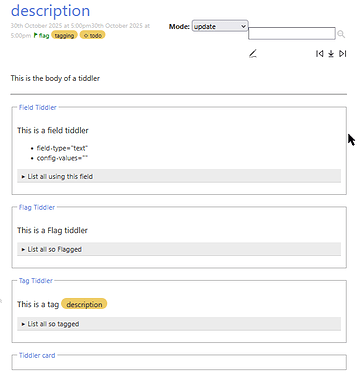You’re dealing with the usual tiddlers and fields. For example:
title: title1
field1:value1
Then field1 is converted into a link.
Through filters or other programming methods, you can derive value1 from title1 and field1. You can also display this value1 to users via views.
I placed all information within the title. For example:
title:title1
title:field1
title:value1
title:title1 field1 value1
Since all these are titles, they are all links.
Currently, I cannot obtain value1 through filters or programming methods. I can only allow users to derive value1 from title1 and field1 via views.
My solution not only retrieves value1 from title1 and field1, but also obtains field1 and title1 from value1. Queries can be performed in either direction, similar to Prolog.
In Prolog, if the information a b c exists, you can query a b X to obtain c, or query X b c to obtain a.
Many phenomena share underlying commonalities.
For instance, tag1 can add supplementary information to title1. For example:
title:title1
tag:tag1
However, if we avoid using tags and instead employ wiki links, we can organize information in a similar manner. For example:
title:tag1
text:[[title1]]
We achieve the tag effect through backlinks.
For example, the following two approaches achieve the same effect:
tag:tag1 tag2
tag1:
tag2:
No solution is unique; alternatives exist for any approach. Multiple paths lead to the same destination. For instance, I replaced the outliner with the table.
My ssspc can also store field name and field value information while generating links. Thus, it aligns with this thread’s core point. It isn’t a field-specific solution. But for storing supplementary information, fields aren’t the only approach.
Therefore, my reminder in this thread is: if you require field values to be links, consider abandoning the field method and adopting the ssspc approach. This provides a ready-made solution.
My approach also qualifies as a no-touch tags solution.
My approach is to attach information to a tiddler in another location.
My approach allows attaching information to multiple tiddlers in bulk.
However, my approach is completely unrelated to TiddlyWiki’s existing information structure. Should I participate in TiddlyWiki discussions?



